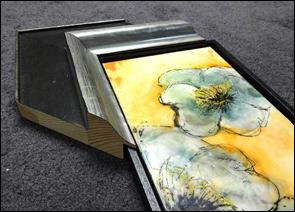 Photo 1
Photo 1
Cap frame 3⅝" over black float.
Capped stack is a phrase I have coined to label the use of a traditional rabbet lip frame with a float frame tucked inside. Last month I shared a basic stack with the small float on top of a flat slant and one with a wide cap. This time we'll look at more extremes for much larger cradles and color contrast inserts.
Wide vs. Deep Cap
The top frame is a 3⅝" wide charcoal black with silver raised lip. The inner black float frame easily fits within the depth of the rabbet for a 4" wide float frame (photo 1). OK, a little too much for this small 6x12" encaustic panel, but consider the possibilities with a 4'x6' cradle. A wider capped float frame is more dramatic and in some cases may better fit with a potential client's décor. That doesn't mean you need to spend the bigger bucks to frame with the larger cap frame, but just knowing the possibilities may aid in the sale of your piece if they are looking for something a little more traditional.
 Photo 1
Photo 1
Cap frame 3⅝" over black float.
The 3" deep white oak cap frame easily firs over a 2" deep black float frame in photo 2 to accommodate a 1¼ to 1½" cradle. Plus many times these are available in other assorted wood tones such as maple, golden oak, cherry, walnut and charcoal.
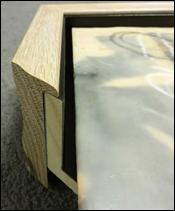 Photo 2
Photo 2
White oak 3" deep over 2" black float.
The sample in photo 3 is shallower than the previous sample but is wider at 4¾" wide by 1¾" deep. The Italian wood has the strength for a heavy mirror and the depth for a 1" deep float frame and comes in three shades. Matching the light walnut coloring of the stacked frames maintains the visual appearance of the unit being a really wide float—and that's the point—to make the stack appear as one (photo 4).
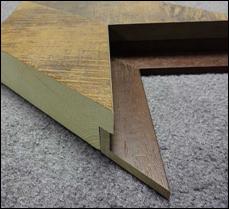 Photo 3
Photo 3
The float must fit within the rabbet and not extend out the back.
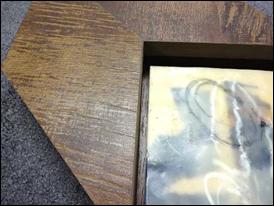 Photo 4
Photo 4
A 5" wide float presentation.
Use of Color
Another interesting concept is to use a contrasting float. A dark walnut carved cap frame is paired with a 1" deep natural white stained float (photo 5). Though a white float by itself is visually a little harsh or stark, when stacked with a darker cap it can prevent the dark float space surrounding a painting from becoming too hollow and dark. The lighter space giver the viewer's eye a place to rest between the art and the cap from, plus the lighter coloring—matching the medium—expands the art to appear larger than it actually is (photo 6).
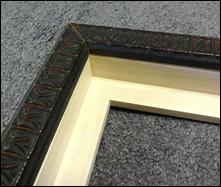 Photo 5
Photo 5
Natural white float with dark carved cap.
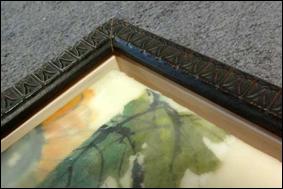 Photo 6
Photo 6
A lighter colored float expands the visual size of the art and prevents a cavernous float space.
The possible combinations for capped floats is limited by width of rabbet and depth of cap, but as long as the float frame comfortably fits inside the cap the overall width, color, style and period makes the combinations a wonderful expansion of the standard contemporary float frame.
END
Copyright © 2013 Chris A Paschke
For more articles on mounting basics look under the mounting section in Articles by Subject.
There is a special section in the library for all past IEA Framing Matters articles from Wax-On!
Additional information on all types of mounting is found in:
The Mounting and Laminating Handbook, Second Edition, 2002,
The Mounting And Laminating Handbook, Third Edition, 2008 and
Creative Mounting, Wrapping, And Laminating, 2000 will teach you everything you need to know about getting the most from your dry mount equipment and materials as an innovative frame designer.
All books are available from Designs Ink Publishing through this website.
Chris A Paschke, CPF GCF
Designs Ink
Designs Ink Publishing
785 Tucker Road, Suite G-183
Tehachapi, CA 93561
P 661-821-2188
chris@designsinkart.com